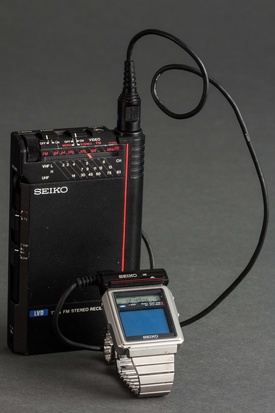Seiko TV Watch
- Company :
- Seiko
- Year :
- 1982
- Manual :
- Seiko TV Watch Manual
The 1982 Seiko TV Watch is a wristwatch with a built-in TV screen. It no longer works, because analog TV broadcasts stopped in the US in June 2009.
The watch was so cool that it was featured in the 1982 James Bond Film “Octopussy.” For a recursive experience you can watch a YouTube video of Octopussy on the watch.
The Guinness Book of Records showed, in its 1984 edition, the SEIKO TV-Watch as the "smallest TV set in the world". This is an interesting theory, since from what you can see here actually looks like the smallest TV by far. Unfortunately a vital detail is missing; the necessary TV receiver is inside a box (model no. TR02-01) approximately the size of a Walkman. The box is connected to the watch via the cable shown on the photograph. The idea was to put the cable through the sleeve of your jacket and hide the receiver in the pocket. Then just put on the earphone (the cable also serves as an antenna) and you can watch TV inconspicuously almost anywhere. Details were hard to recognize because of the slow and low contrast liquid crystal display.
The TV-Watch by HATTORI SEIKO CO., LTD (founded way back in 1881) was presented in Tokyo during the summer of 1982 (16th of July or 23rd of September, according to different sources). Some hundred million yen were invested in its development. In the beginning, the TV-Watch was only available in Tokyo and Osaka as DXA001 for 108,000 Yen, later also as DXA002 all over Japan for 98,000 Yen (at that time about 500 and 600 Euro, respectively). Both versions are said to differ only by the case design (the first edition DXA001 had a black outline) and the headphone, the less costly package being only equipped with an earphone. In the US, the TV-Watch was sold from 1983 on. The first (and nowadays hardly available) version T001-5000 was sold in a silver colored cardboard box. The protective pouch for the receiver also came in a silver color. The much more frequently found later version T001-5019 was delivered in a gold colored box. Strangely, the obviously highly pessimistic developers expected the LCD module to last only about seven years.
Regardless of its "factual impracticality" the SEIKO TV-Watch is the holy grail of every pocket TV collection. Its fascination is unbeaten. The TV-Watch was seen on the big screen several times. In 1983, Roger Moore wore a TV-Watch in Octopussy instead of the usual Rolex Submariner. In 1987, you could see one on Tom Hanks' wrist in the comedy Dragnet. Naturally in both movies it came without the earphone (or antenna respectively) and in Octopussy it even had a color screen. Partly because it was seen in a Bond movie, the prices for the TV-Watch rocketed. Well-kept models in original packaging are rarely sold for less than $500. Unused copies may change owners for as much as $1,000. The retail price in the US was $495.
Technical details are quickly listed: 1.2" display w/o background lighting ("blue/white", 31,920 pixels, 10 shades of grey, 16.8 * 25.2mm), 5 hours running time on one set of batteries, external tuner for VHF & UHF (channels 2 to 83!) and FM stereo radio reception. The watch in its original function can be "misused" as a stop watch (resolution 1/100 seconds) and as an alarm-clock. The flexible 6-conductor cable supplies three different voltages (4, 9 and 13 Volt) with separate signals for video and synchronization. The only optional accessory was the AC adapter TD02. If you're curious about the other features of the TV-Watch, there is a link to the user's manual (PDF, 2.4 MB - with thanks to Olivier Bideau from Le Mans, France).
Extensive technical data can be found on Jochen Huebl's TV-Watch website (in German). You can also see the watch "in action" (AVI/DivX, 2 MB). The website "Television History - The First 75 Years" has also reserved a chapter for the TV Watch. Connoisseurs of the Japanese language and fans of cute photos will also enjoy the colorful brochure pages, which can be found behind the following links: page1, page2, page3 (about 250 kB each). I only ever found one brochure in English, which advertises the watch under the brand name EPSON (SEIKO and EPSON are a single company since 1985). In July 1983, the magazine Video Review published a field report about the TV-Watch. And in Germany, the electronics magazine ELO (which has ceased to exist a long time ago) reported in October 1982 about this unique high-tech toy. Like in Octopussy, this article showed the prototype of the TV-Watch. The writing "SUWA SEIKOSHA" was replaced by "SEIKO" for mass production and the cable connector was metal covered in the original version.
The retail package included, in addition to all sorts of literature, a leather pouch for the tuner and three spare elements for the wristband. The valuable (because no longer available) connecting cable is about 80 cm in length. The watch measures 40 X 49 X 10 mm and with a stainless steel wristband and coin-sized battery (type SR920W) it weighs slightly more than 80 grams. The receiver weighs almost 190 grams with 2 AAA batteries. The TV-Watch was made in the Fujimi and Matsumoto Japan factories from 1982 to 1983.

